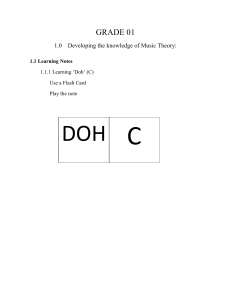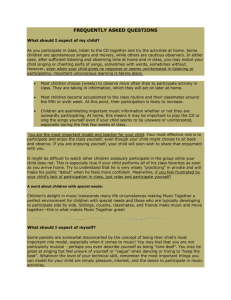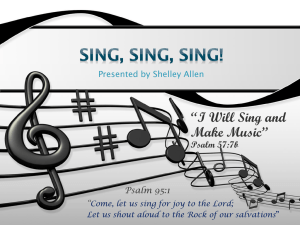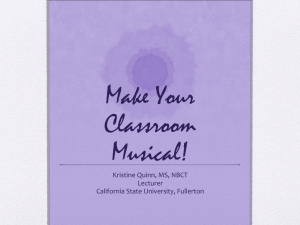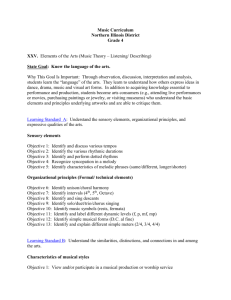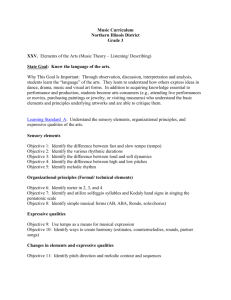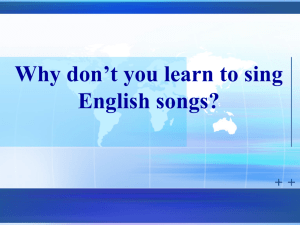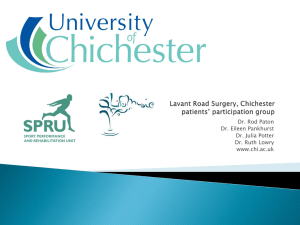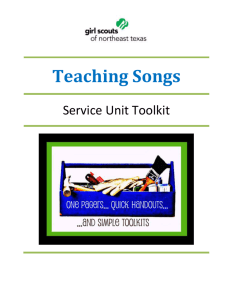Music and EAL/overview
advertisement
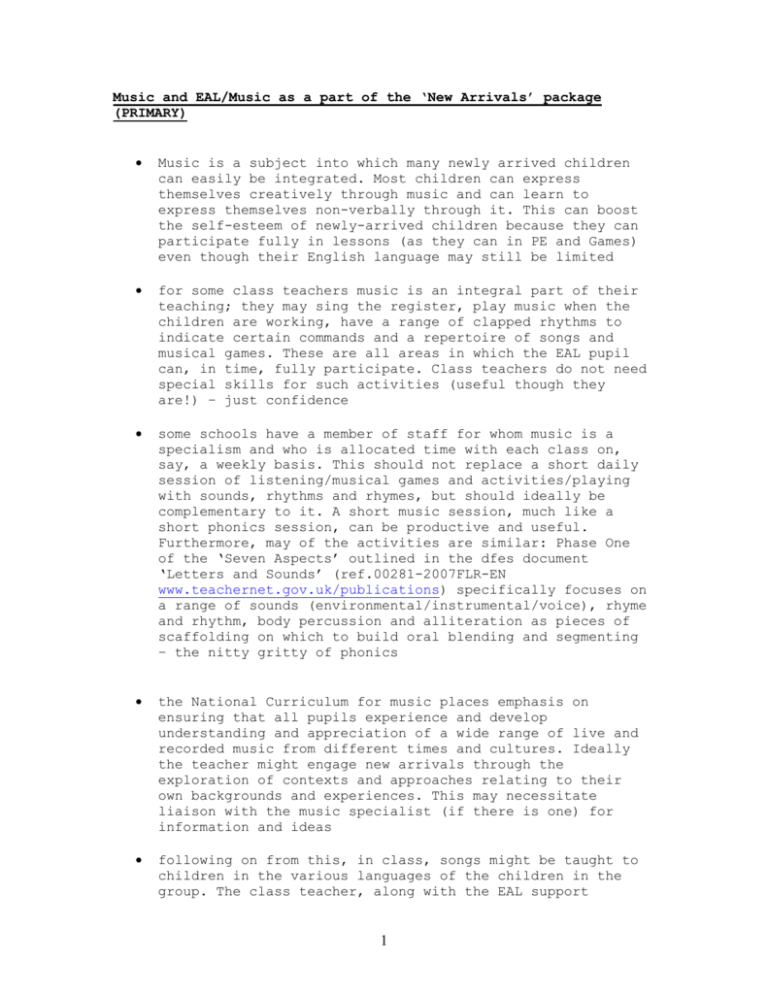
Music and EAL/Music as a part of the ‘New Arrivals’ package (PRIMARY) Music is a subject into which many newly arrived children can easily be integrated. Most children can express themselves creatively through music and can learn to express themselves non-verbally through it. This can boost the self-esteem of newly-arrived children because they can participate fully in lessons (as they can in PE and Games) even though their English language may still be limited for some class teachers music is an integral part of their teaching; they may sing the register, play music when the children are working, have a range of clapped rhythms to indicate certain commands and a repertoire of songs and musical games. These are all areas in which the EAL pupil can, in time, fully participate. Class teachers do not need special skills for such activities (useful though they are!) – just confidence some schools have a member of staff for whom music is a specialism and who is allocated time with each class on, say, a weekly basis. This should not replace a short daily session of listening/musical games and activities/playing with sounds, rhythms and rhymes, but should ideally be complementary to it. A short music session, much like a short phonics session, can be productive and useful. Furthermore, may of the activities are similar: Phase One of the ‘Seven Aspects’ outlined in the dfes document ‘Letters and Sounds’ (ref.00281-2007FLR-EN www.teachernet.gov.uk/publications) specifically focuses on a range of sounds (environmental/instrumental/voice), rhyme and rhythm, body percussion and alliteration as pieces of scaffolding on which to build oral blending and segmenting – the nitty gritty of phonics the National Curriculum for music places emphasis on ensuring that all pupils experience and develop understanding and appreciation of a wide range of live and recorded music from different times and cultures. Ideally the teacher might engage new arrivals through the exploration of contexts and approaches relating to their own backgrounds and experiences. This may necessitate liaison with the music specialist (if there is one) for information and ideas following on from this, in class, songs might be taught to children in the various languages of the children in the group. The class teacher, along with the EAL support 1 teacher, could research these or ask children and their parents for material/ advice on pronunciation etc. many schools already provide a range of opportunities to promote and celebrate the different cultures, languages and backgrounds of their pupils - using the creative arts (dance, drama and music, especially singing, at primary level). the units of work in the music scheme of work (every school should have one) might be adapted to meet the needs of new arrivals (there are a number of units, grouped two-yearly: 1/2, 3/4, 5/6), covering such items as ‘Exploring Sounds’ and ‘Exploring Instruments and Symbols’. The class teacher or music specialist will already be aware of these. TO REITERATE: Elements of music might constitute an important part of work done with new arrivals, especially clapping and rhythms, the use of a range of simple percussion instruments and singing (chants, poems, folk songs). Such activities are possible 1:1, in pairs, small groups and whole class sessions and could be adapted as appropriate. Furthermore, such activities complement the activities which promote language acquisition and in which each primary year group is involved on a daily basis Basic Music Activities for the non-specialist special equipment is not needed, although a ball and a small drum or tambour would be useful; most schools have a range of tuned and untuned percussion instruments and the non-specialist can easily become familiar with the different types ‘Simon Says’ is a good starting point; it’s fun, it’s straightforward and can be played by two people or thirty people. Other similar games exist: Don’t Clap This One Back’ involves clapping rhythms for the child/ren to copy. But the rhythm of the title is taboo! If you clap it back you are either ‘out’ or you foreit a life (or have to do a forfeit…..name three fruits/count to twenty etc) from here you can progress by using voice rhythms and patterns – your name, the child’s or children’s names, countries, colours, fruits, vegetables, parts of the body etc – all the usual EAL beginner vocabulary and topics, but useful for the whole class and at a variety of levels 2 these can be extended and developed by varying your voice, the tempo (speed) at which you speak or clap, changes in volume (dynamics), style and pitch (high and low) etc. Poetry is a fantastic resource and it is possible to ‘orchestrate’ a poem – think choral speaking – so that children are suing their voices as instruments. Simple role play also provides opportunities for learning and fun in order to get the children to sing, gradually introduce simple note patterns (2 to 3 notes); if you really lack confidence on the singing front use familiar tunes (twinkle, hot cross buns, frère Jacques etc) and change the words to suit your topic: I am clapping, I am clapping / So are you, so are you / wiggle all your fingers, wiggle all your fingers / Now just two, now just two the younger the child, the greater the likelihood that they will immediately join in singing with you – even before they have heard the tune! Most children in the Primary years will sing, with encouragement, although the cool boys in Year 6 may well need a bit of persuasion. A small keyboard (again, most schools will have a few) is extremely useful here – it does the music-making for you chime bars or a glockenspiel/xylophone can be useful in a number of ways, not only for providing the opportunity to play tunes but to introduce adjectives (low/high, big/small) and comparatives (louder/quieter, taller/shorter). In fact any instrument (and you don’t need to be able to play it properly) can be used to explore mathematical vocabulary and concepts as well as musical ones (guitar/violin/the inside of a piano/trombone…..) the next stage would include some action songs. The most obvious ones are counting songs like Ten Green Bottles, but innumerable collections exist – libraries are a good source and the books are free. The organisation Sing for Pleasure (http://www.singforpleasure.org.uk/) is a fantastic resource and produces small booklets with a range of games, chants, rounds and action songs, as well as more challenging repertoire for the music specialist the internet is a good source of material too; Panie Janie (Google it and you will find it) is the Polish Frère Jacques. Once I had taught it to a Year 4 pupil (and she had fallen about laughing at my attempts to speak Polish) she in turn taught it to the children in Y3 (who already knew the tune of course), who sang it (in Polish, and subsequently French, as there were two French children in the class) as a round in three parts 3 rounds are very useful; the words are often repetitive, the tunes are simple and they are challenging and fun to sing, although difficult to do 1:1 ( Flying a Round-88 Rounds and Partner Songs A&C Black ) Most children know how rounds work – even if they find them difficult to get right. To get them used to singing in parts (rather than in unison – altogether) ‘echo’ songs and chants are wonderful; many African chants are call-and-response songs, are relatively simple to sing and sound great game-songs can be used to teach colours/shapes/body parts/topic vocabulary etc); another excellent resource is the sing up website (http://www.singup.education.co.uk/). In January 2007 Howard Goodall was appointed as England’s first ever National Ambassador of Singing, leading a 4-year £40 million government programme to improve the provision of group singing for all primary-age children. The Sing Up website, set up to support this venture, has a ‘Song Bank’ featuring songs and printable music, as well as recorded music it is possible to download (and burn on to CDs). There are folk and traditional songs too many many music schemes exist and most primary schools will have material worth a look and a CD/cassette player that can be borrowed. Compilation CDs (loads of cheap ones available in supermarkets, and teachers will have their favourites) offer a range of short pieces and extracts that might be played to elicit vocabulary (fast/slow/high/low/exciting/boring/happy/sad etc) – but any music (especially popular music – the songs from High School Musical/Mamma Mia for example) is a potential resource And a fantastic singing voice, while useful, is not vital; songs can be taught using a CD if a teacher lacks confidence in this area, and it is usually possible to engender enthusiasm in children of this age group if you are enthusiastic yourself but if you really feel you can’t sing – look at the enclosed sheet (SingUp/can’t sing?) for some encouragement – and to see the many ways in which it is ‘good’ for you (and all children). This sheet also outlines the Singing Playgrounds project in Birmingham, which has been very successful I have just scratched the surface of musical possibilities here; hopefully the non-specialist will find something, however small, to add to his/her teaching repertoire 4 5
